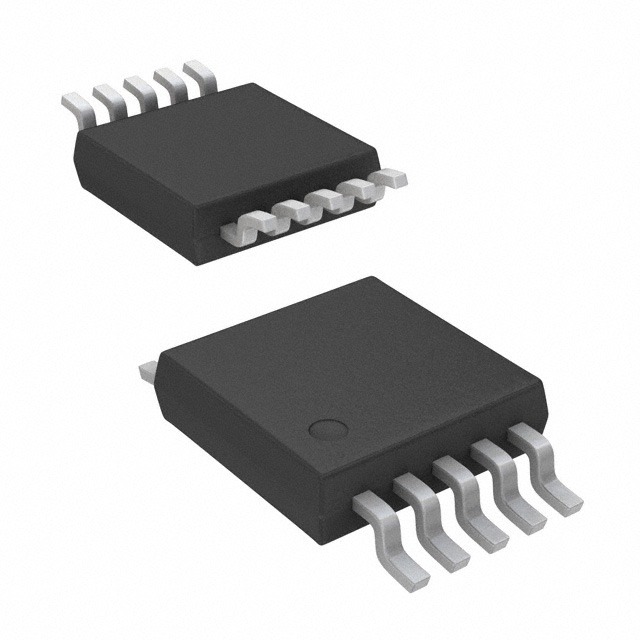AD5243BRM10
Product Overview
- Category: Integrated Circuit
- Use: Digital Potentiometer
- Characteristics: Dual-channel, 256-position, I2C interface
- Package: 10-Lead MSOP
- Essence: Provides digitally controlled resistance adjustment
- Packaging/Quantity: Tape and Reel, 2500 units per reel
Specifications
- Resolution: 8-bit (256 positions)
- Number of Channels: 2
- Interface: I2C
- Supply Voltage: 2.7V to 5.5V
- Temperature Range: -40°C to +125°C
- Resistance Tolerance: ±20%
- End-to-End Resistance Range: 10kΩ, 50kΩ, 100kΩ
Pin Configuration
The AD5243BRM10 has a 10-lead MSOP package with the following pin configuration:
- VDD - Positive power supply
- SDA - Serial data input/output for I2C communication
- SCL - Serial clock input for I2C communication
- A0 - Address bit 0
- A1 - Address bit 1
- GND - Ground
- RDAC1 - Terminal A of channel 1 resistor
- RDAC2 - Terminal B of channel 1 resistor
- RDAC3 - Terminal A of channel 2 resistor
- RDAC4 - Terminal B of channel 2 resistor
Functional Features
- Dual-channel digital potentiometer
- Allows precise resistance adjustment through digital control
- I2C interface enables easy integration into various systems
- Non-volatile memory stores wiper position during power-off
- Low power consumption for energy-efficient applications
- Wide operating temperature range for versatile usage
Advantages and Disadvantages
Advantages: - Precise and accurate resistance adjustment - Easy integration into digital systems - Non-volatile memory ensures settings are retained - Low power consumption for energy efficiency - Wide operating temperature range allows usage in various environments
Disadvantages: - Limited resolution (8-bit) - Resistance tolerance of ±20% may not be suitable for high-precision applications
Working Principles
The AD5243BRM10 is a digital potentiometer that replaces traditional mechanical potentiometers. It consists of two channels, each with 256 positions, allowing precise resistance adjustment. The device communicates through the I2C interface, enabling easy control from a microcontroller or other digital devices.
When a digital value is sent via the I2C bus, the AD5243BRM10 adjusts the resistance between its terminals accordingly. The non-volatile memory ensures that the wiper position is retained even when power is removed.
Detailed Application Field Plans
The AD5243BRM10 finds applications in various fields, including:
- Audio Systems: Volume control, tone adjustment
- Instrumentation: Calibration, signal conditioning
- Industrial Control: Variable resistance control, feedback circuits
- Communication Systems: Signal attenuation, impedance matching
- Automotive Electronics: Climate control, lighting control
Alternative Models
- MCP401X: Microchip Technology, Inc.
- MAX548X: Maxim Integrated
- DS180X: Dallas Semiconductor
These alternative models offer similar functionality and can be considered as replacements for the AD5243BRM10.
In conclusion, the AD5243BRM10 is a dual-channel digital potentiometer with precise resistance adjustment capabilities. Its I2C interface, non-volatile memory, and wide operating temperature range make it suitable for various applications. However, its limited resolution and resistance tolerance should be considered for specific use cases.
Senaraikan 10 soalan dan jawapan biasa yang berkaitan dengan aplikasi AD5243BRM10 dalam penyelesaian teknikal
Sure! Here are 10 common questions and answers related to the application of AD5243BRM10:
Q: What is AD5243BRM10? A: AD5243BRM10 is a digital potentiometer IC (integrated circuit) that can be used to digitally control resistance in various technical applications.
Q: What is the operating voltage range of AD5243BRM10? A: The operating voltage range of AD5243BRM10 is typically between 2.7V and 5.5V.
Q: How many channels does AD5243BRM10 have? A: AD5243BRM10 has two independent channels, allowing for simultaneous control of two separate resistances.
Q: What is the resolution of AD5243BRM10? A: AD5243BRM10 has a resolution of 256 steps, meaning it can provide 256 different resistance values.
Q: Can AD5243BRM10 be used as a variable gain amplifier? A: Yes, AD5243BRM10 can be used as a digitally controlled variable gain amplifier by adjusting the resistance in the feedback network.
Q: Is AD5243BRM10 compatible with I2C communication? A: Yes, AD5243BRM10 uses the I2C interface for communication, making it compatible with microcontrollers and other I2C devices.
Q: What is the temperature range for AD5243BRM10? A: AD5243BRM10 has an extended industrial temperature range of -40°C to +125°C, making it suitable for various environments.
Q: Can AD5243BRM10 be used in audio applications? A: Yes, AD5243BRM10 can be used in audio applications for volume control, tone adjustment, and other audio signal processing tasks.
Q: Does AD5243BRM10 have non-volatile memory? A: Yes, AD5243BRM10 has non-volatile memory that allows it to retain its settings even when power is removed.
Q: What are some typical applications of AD5243BRM10? A: Some typical applications of AD5243BRM10 include instrumentation, test equipment, audio systems, motor control, and programmable voltage references.
Please note that these answers are general and may vary depending on the specific requirements and use cases.


